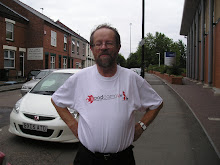17 October 2007
Travelling to Rome, after a quick detour to Pisa, to see the famous leaning thingee. We had to get a bus to it, and it does lean fairly dramatically (the thingee, not the bus - though that was pretty rough as well). I wouldn’t trust getting on it, though people were climbing to the top quite happily. The cathedral it’s alongside is also leaning a bit, I think, though Celia wasn’t convinced.
Pisa was very hot, and it’s got hotter since. We’re travelling down the coast some of the time, though at present we’ve lost sight of it. It’s nice to be near some sea again.
My post about yesterday’s sightseeing was a bit short, and during the early hours I was thinking what else I should say, but, as though things do, they’ve now dissipated. I meant to explain what a double recorder was: seemingly it’s something you can blow two notes on at once, as it not only has two mouthpieces (very close together) but also the note holes are separated into two halves. Be interesting to have a go on. There were richly endowed early keyboards, one with some thousand jewels embedded into its surface. The serpent I spoke of yesterday is a serpent-shaped horn, seldom used in orchestras or bands these days, but reasonably popular in its brief heyday. There were some other pseudo-serpents: instruments that looked playable but were probably just for use in a theatre performance. One violin had an absolute encrustation of carving on its underside; would have been quite uncomfortable to hold, I think. It was sitting alongside a Stradivarius, that doyen of violins. There was an upright piano - literally. The keyboard was still in the same position as usual, but the strings were vertical, as they are in modern uprights. However, the difference was that these strings were arranged in the way a grand’s strings are.
The Palazzo Vecchio, apart from what I said about it yesterday, has room after room upstairs with decorated ceilings. I don’t mean a pattern painted on, but umpteen paintings, some mythic, some religious. The artists must have worked years on the place. It also has many wonderful craft works on display: items that are for practical use but have been adorned by men (perhaps women) with an artistic nature, and the results are just wonderful. Superbly fine carving in bone with details so minute you wonder how they managed to avoid damaging the work. It was the same with Michaelangelo’s David: one misstep in the making, and this enormous work would have had to have been abandoned. The actual statue is twice human size, I’d gauge, and it stands on a plinth that’s about human size again. So it towers above you. You can’t see some of the detail, but we were looking at a book after we’d viewed the statue, and the eyes are done in such a way that they appear to be looking at something. They’re not just blank, in other words. The strap of his sling is pitted, as though it was some material. The details of the limbs are extraordinary (though of course Michaelangelo wasn’t the only master of such details); but there is a sense of human flesh under the skin, and there are even veins showing in places.
We also saw statues by Benvenuto Cellini yesterday - he was virtually Michaelangelo’s equal in his ability to work with stone, and various other wonderful artists whose names didn’t mean so much to me.
Subscribe to:
Post Comments (Atom)

No comments:
Post a Comment